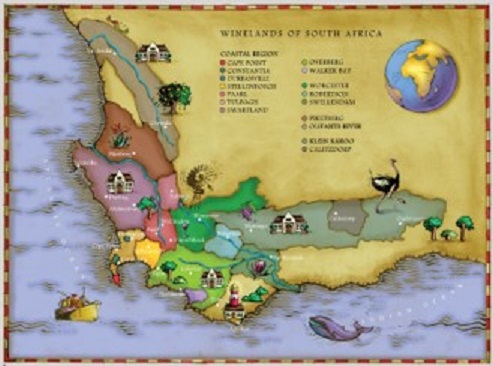Initial Quest
The 17th century marks the beginning of the wine industry in South Africa. The year was 1655 when the first grapes were planted by a Dutch settler. The first bottle was produced in Cape Town by Jan van Riebeeck, the Dutch station manager for the Dutch East India Company who arrived in 1652 to establish a refreshment station – supplying fresh produce to its merchant fleet at the Cape of Good Hope. Why produce wines? It appears that the intent of his venture was to keep scurvy away from the sailors during their voyages along the spice routes to India and the East. His first harvest was February 2, 1659, 7 years after landing (1652).
Simon van de Stel followed Riebeeck, and was able to improve the quality of the viticulture and increased the number of acres, establishing the Constantia wine estate. Upon his death, the winery went fallow until 1778, when it was purchased by Hendrik Cloete.
Even in the 18th century, the wines of South Africa were popular and European aristocrats preferred these wines and it was a favorite of Napoleon Bonaparte. The sweet wines from Constantia were considered among the world’s best in the 18th and 19th centuries.
Because of distance, political and social issues, growers stopped making wine, turning the soil over to orchards and alfalfa fields to feed the growing ostrich feather industry. As time and economics changed, growers started to replant grapevines, selecting high-yielding grapes (i.e., Consault) and by the early 1900s more than 80 million vines had been replanted which, unfortunately, created a “wine lake” -producers, focusing on quantity over quality, were making unsaleable wine and poured it into local rivers and streams.
There definitely was an imbalance between supply and demand, creating depressed prices. This critical situation prompted the government to form Kooperatieve Wiibouwers Vereiging Van Zuid-Afrika Bpkt (KWV) in 1918. The organization was tasked with setting policies and prices for the entire South African wine industry. To deal with the wine glut, the KWV restricted yields and set minimum prices, encouraging production of brands and fortified wines.
20th Century Mindful
In the 1990s, Apartheid ended and the world’s export markets opened for the wines from South Africa. Producers adopted new viticulture, winemaking techniques and technology, focusing on Shiraz, Cabernet Sauvignon and Chardonnay. The reorganization of KWV into a private enterprise sparked innovation and improvement in quality, forcing vineyard owners and wineries to become competitive and the focus of wine making shifted from quantity to quality. By 2003, 70 percent of the grapes harvested reached the consumer market as wine.
Currently, 93,021 ha of vines produce wine grapes and are under cultivation in South Africa over an area approximately 498 miles in length. The major vineyards are centered near Constantia, Paarl, Stellenbosch and Worcester. There are approximately 60 appellations in the Wine of Origin (WO) system that was started in 1973 with a hierarchy of designated production regions, districts and wards.
WO wines must contain: READ THE FULL ARTICLE AT WINES.TRAVEL.
(eTN): South African Wine Adventures | re-post license | post content























